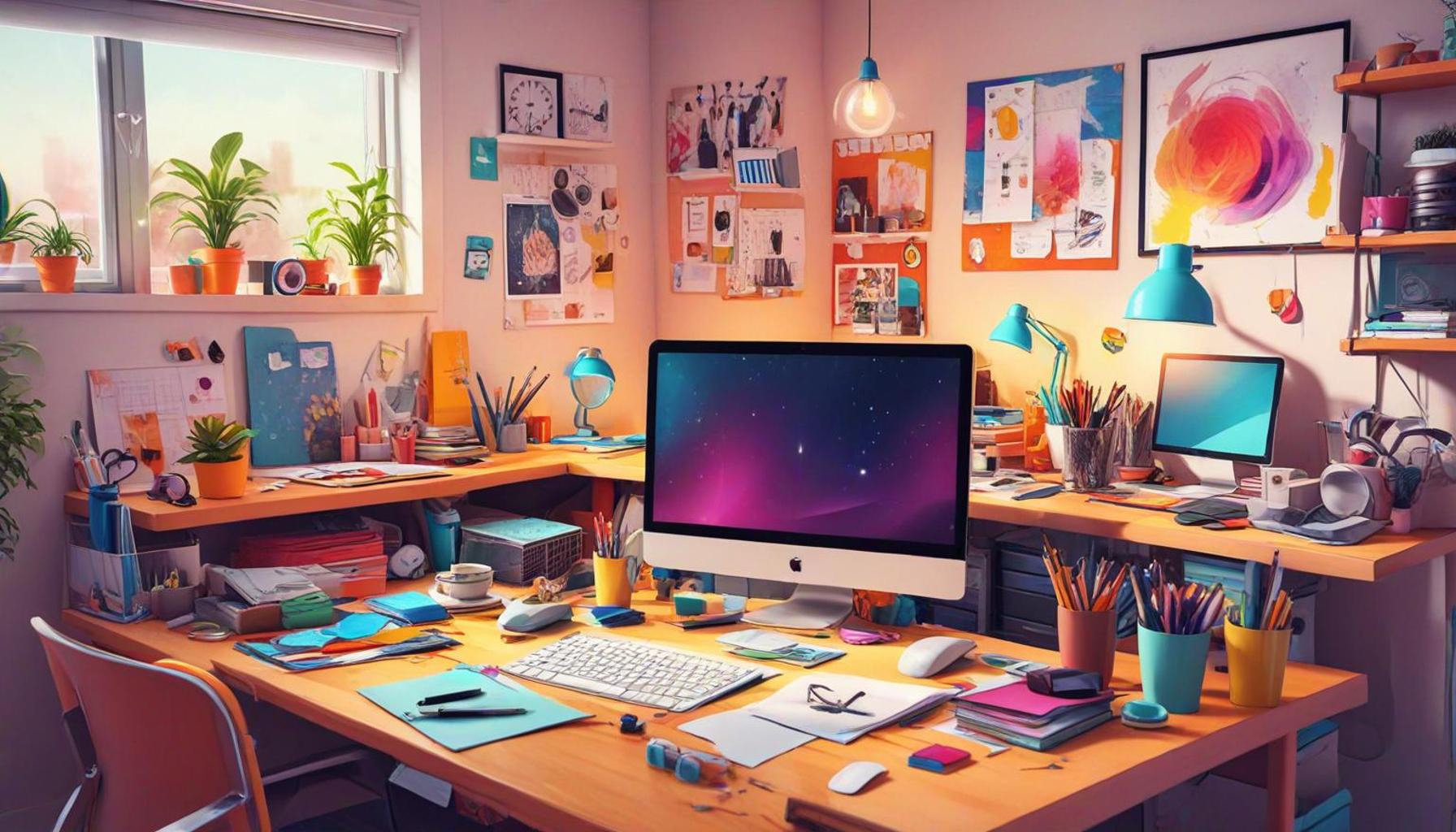Organizing the Workspace: Tips for Creating a Productive and Clutter-Free Environment

In the hustle and bustle of daily life, a well-organized workspace can serve as a powerful catalyst for achieving optimal productivity. The physical space where we work greatly influences our mental states. A clutter-free environment does more than just create a pleasant aesthetic; it can significantly enhance focus, stimulate creativity, and mitigate stress. The question is: are you prepared to transform your workspace into a beacon of efficiency and inspiration?
Benefits of Organizing Your Workspace
Establishing an orderly workspace can lead to numerous advantages, including:
- Increased Productivity: A tidy area minimizes distractions and helps you concentrate. Research shows that individuals working in organized settings are more likely to meet deadlines and perform at higher levels. For example, a study conducted by Princeton University found that a decluttered environment increases the brain’s ability to focus, allowing for greater efficiency in task completion.
- Improved Mental Clarity: Clutter can cloud your thoughts, while an efficient arrangement promotes clarity. When your surroundings are free from chaos, it becomes easier to prioritize tasks and make decisions swiftly. This mental clarity can lead to better problem-solving, allowing you to tackle challenges with confidence.
- Enhanced Creativity: A serene workspace encourages innovative thinking and problem-solving. Psychological studies have demonstrated that a well-organized environment can fuel creativity; artists and designers often report feeling more inspired and focused when their workspace is clear of distractions. By creating a designated area for brainstorming, you can foster an environment that promotes original ideas.
Essential Tips for a Productive Environment
Creating a functional workspace requires a thoughtful approach. Here are some key tips to get started:
- Purge Unnecessary Items: Regularly declutter by removing items you no longer use. Consider following the one-in-one-out rule: for every new item you bring into your space, remove an existing one. This practice will help maintain a clean workspace over time.
- Establish Zones: Designate specific areas for different tasks to streamline functions. For instance, create a zone for computer work, another for reading, and perhaps a separate space for meetings. This designated zoning can help your brain shift gears seamlessly when transitioning between different activities.
- Invest in Storage Solutions: Use organizers, shelves, and bins to keep everything in its place. Opt for vertical storage solutions when space is limited, allowing you to maximize your area while keeping it organized and functional. Clear storage bins can provide visibility to your supplies while maintaining a tidy appearance.
By implementing these strategies, you can easily create a workspace that fosters productivity and encourages a clutter-free mindset. A well-structured environment not only benefits you in the present but also contributes to long-term success and well-being. Delving into the organization of your workspace can unlock your full potential, enhance your work-life balance, and positively impact your overall mental health. Why not start today?
DISCOVER MORE: Click here to transform your life

Essential Strategies for Streamlining Your Workspace
When it comes to creating a productive and clutter-free workspace, it’s essential to adopt an organized approach. A disorganized desk can hinder your ability to focus and complete tasks efficiently. Here are some effective strategies to transform your workspace and foster a more productive environment:
- Assess Your Current Setup: Before diving into organization, take a moment to review your existing workspace. What items are essential, and which ones can be discarded? Taking inventory helps you identify the clutter sources that disrupt your workflow. A clean slate enables you to visualize the optimal arrangement for your tools and resources.
- Create a Daily Cleaning Routine: Establishing a cleaning routine can keep your workspace organized consistently. Dedicate the last few minutes of your workday to tidy up. Put items back in their designated places, clear off your desk, and prepare for the next day. This simple habit can substantially improve the overall aesthetics of your workspace and help maintain focus.
- Utilize Technology Wisely: In today’s digital age, many resources can contribute to organizational success. Use productivity apps such as Trello or Asana to manage your tasks, and consider virtual note-taking tools like Evernote to keep your thoughts organized. By integrating technology, you can alleviate physical clutter while enhancing your productivity.
- Personalize Your Space: An inviting workspace can improve your mood and inspire creativity. Incorporate elements that resonate with you, whether it’s artwork, plants, or motivational quotes. Just be mindful not to overcrowd the space; the goal is to enhance, not to clutter. A well-balanced personal touch can serve as a motivation boost during your work hours.
- Implement Cable Management: In the age of technology, cables and chargers can create a tangled mess that detracts from an organized workspace. Use cable organizers, clips, or sleeves to keep them under control. Not only will this reduce visual clutter, but it will also improve your safety and functionality.
By employing these strategies, you can cultivate a space that not only looks good but works efficiently. A well-ordered workspace helps you achieve a clearer mind, enhances your focus, and paves the way for creativity. As you reorganize your environment, remember that the ultimate goal is to create a setting that empowers you to be the best version of yourself during work hours. A few small changes can lead to substantial improvements in productivity, so why not embark on this transformation today?
Organizing the Workspace: Tips for Creating a Productive and Clutter-Free Environment
Maintaining an organized workspace is essential for maximizing productivity and minimizing stress. By implementing effective strategies, you can create an environment that fosters creativity and efficiency. In this section, we delve deeper into practical tips that will help you achieve a clutter-free and productive workspace.
Utilize Proper Storage Solutions
One of the central keys to an organized workspace is effective storage. Invest in modular shelving, cabinets, and file organizers to keep essential documents and materials at hand while reducing clutter. Use labeled bins or folders to categorize your items, making retrieval easy and efficient.
Embrace Minimalism
Adopting a minimalist approach can significantly enhance your workspace. Evaluate the items on your desk and remove anything that is unnecessary or does not serve a functional purpose. A streamlined environment can lead to improved focus and creativity.
Create Zones for Different Activities
Establishing designated zones for specific activities can reduce chaos and enhance workflow. For instance, set up separate areas for computing, paperwork, and brainstorming. This segmentation allows you to switch tasks more efficiently and maintains an organized feel throughout the workspace.
Regular Decluttering Routine
Incorporating a regular decluttering routine into your schedule is crucial. Set aside ten minutes at the end of each day to tidy up your workspace. This habit will prevent the accumulation of clutter and help you start each day fresh and organized.
| Category 1 | Category 2 |
|---|---|
| Storage Solutions | Effective use of shelves and organizers for easy access and reduced clutter. |
| Minimalism | Less is more; removing unnecessary items can enhance focus. |
Utilize Technology Wisely
Leverage technology to keep your workspace organized. Utilize digital tools such as task management apps and cloud storage solutions to minimize physical clutter. Digitalization can streamline your workflow and make accessing information simpler and faster.
Personalize Your Space
While keeping clutter at bay, don’t forget to inject some personality into your workspace. Inspirational quotes, plants, and personal artifacts can motivate and keep you engaged while providing a pleasant atmosphere. Just remember to keep personal items minimal to avoid distraction.
By incorporating these strategies, you’ll create a productive workspace that not only looks appealing but also supports your daily tasks effectively. With the right organization and a little effort, you can transform your environment and enhance your overall productivity.
EXPLORE MORE: Click here for innovative small space design ideas
The Importance of Decluttering and Efficient Space Utilization
As you work towards creating a productive and clutter-free workspace, it is vital to recognize the significance of both decluttering and efficient space utilization. A thoughtfully organized workspace does not merely rely on the absence of visible clutter, but rather on a system that nurtures both functionality and comfort. Here are some key considerations to elevate your workspace organization:
- Adopt the “One In, One Out” Rule: To maintain a clutter-free environment, consider implementing the “One In, One Out” strategy. Whenever you acquire a new item—be it a book, a tool, or office supply—commit to removing an existing item. This ensures that your inventory remains manageable and prevents unnecessary accumulation that can hinder productivity.
- Design Zones Based on Tasks: Think about how you can segment your workspace into different zones according to your tasks. For instance, create a dedicated area for computer work, another for writing or brainstorming, and perhaps a small section for relaxation or inspiration. By zoning your workspace, you can improve your focus by reducing distraction and providing a specific area for each type of work.
- Optimize Vertical Space: Many people overlook vertical space that can be an asset in an organized workspace. Wall-mounted shelves, pegboards, and floating organizers can help you maximize storage without sacrificing desk space. Storing items off the desk can create a sense of openness and clarity, promoting a conducive work atmosphere.
- Incorporate Storage Solutions: Invest in versatile storage solutions, such as multi-drawer units or modular shelving systems that can adapt to your needs. Clear bins or labeled containers are also effective for sorting supplies and documents. This not only streamlines your workspace but also simplifies the retrieval process, keeping disruption to a minimum.
- Go Paperless when Possible: In a world that increasingly values digital solutions, going paperless is a powerful option for reducing clutter. Transitioning to digital files can eliminate the need for physical documents, thus freeing up valuable space. Utilize cloud storage services like Google Drive or Dropbox for secure and accessible digital document management, which can also increase collaboration efficiency.
Statistics suggest that people spend an average of 4 hours a week searching for misplaced items, which underlines the importance of an organized workspace. A systematic approach not only saves valuable time but also reduces stress and enhances creativity. As you continue this journey, think about the long-term benefits of maintaining a streamlined workspace; improved concentration, a clearer thought process, and enhanced creativity are just the tip of the iceberg.
Incorporating simple yet effective organization techniques will translate not only into greater productivity but also foster a positive work environment. Remember, the key lies in establishing habits that promote a lasting sense of order. Engage with your workspace, and watch as it transforms into an efficient haven tailored to your professional needs.
DISCOVER MORE: Click here to dive deeper
Final Thoughts on Workspace Organization
In conclusion, establishing a productive and clutter-free workspace is pivotal not only for enhancing efficiency but also for fostering creativity and reducing stress. By focusing on key strategies such as decluttering, designing functional zones, and optimizing storage, you can create an environment that supports your workflow and aligns with your professional goals. Embracing tools like digital organization and versatile storage solutions allows you to adapt to changing needs and minimize unnecessary distractions.
It’s important to understand that organizing your workspace is an ongoing process rather than a one-time task. Regularly evaluating your environment and implementing the “One In, One Out” rule ensures that you maintain a streamlined area that encourages productivity. Furthermore, investing time in developing new habits related to workspace management can lead to significant long-term benefits in both personal satisfaction and work performance.
As you embark on this journey of workspace transformation, remember that a structured setting can translate into sharper focus, improved time management, and enhanced overall well-being. So take the first steps today—experiment with different organization methods, assess what works best for you, and watch your workspace evolve into a dynamic haven of productivity. By prioritizing your work environment, you set the stage for success and creativity that can propel you toward your greatest achievements.



